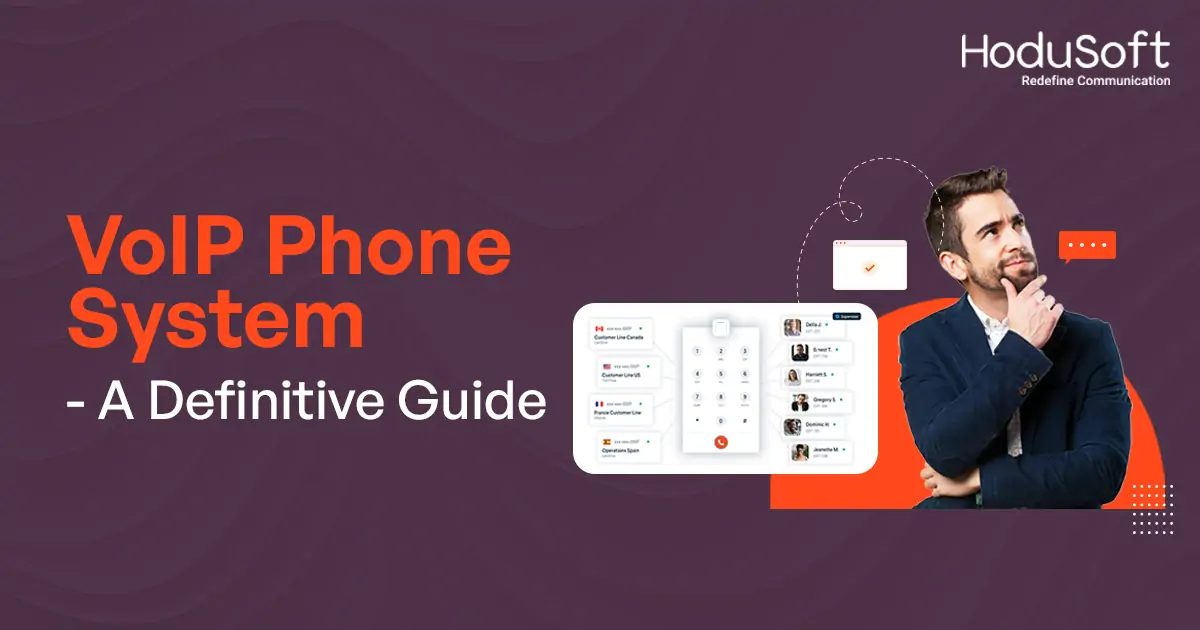VoIP Phone System - A Definitive Guide
As internet systems continue to evolve, more and more companies are turning to VoIP as their communication solution of choice. With the global VoIP market valued at a whopping $123.3 billion in 2021, it’s clear that this technology is here to stay. Not only is it modern and cost-effective, it also offers a multitude of features that traditional landline phone systems simply cannot match.
But before you make the switch, it’s important to understand the pros and cons of VoIP versus traditional phone systems. In this blog, we’ll provide a comprehensive comparison of both types of systems and explain how VoIP works through some prominent examples. We will also walk you through the setup process – read on to learn more and discover if VoIP is the right choice for your business.
What is a VoIP Phone System?
VoIP, or Voice over Internet Protocol, is a technology that allows users to transmit voice messages and other types of communication over the internet.
VoIP is quickly becoming a popular choice for businesses who are looking to upgrade from traditional phone systems, such as the public switched telephone network (PSTN), also known as the plain old telephone service (POTS). It converts voice signals into digital data in data packets, which are then transmitted over the internet via a router.
The VoIP phone system has transformed the way businesses approach communication. Let’s delve deeper into how the VoIP call system excels compared to the conventional VoIP business phone system.
VoIP vs. Landline Phone System: The Key Differences
Landline phone systems, also known as Public Switched Telephone Network (PSTN) or Plain Old Telephone Service (POTS), use physical phone lines to transmit calls while VoIP systems utilize the internet to connect specific internet-enabled devices. Both VoIP and landline phone systems have their own unique features and capabilities, and choosing the right one for your business or personal use can be challenging. So, here’s the highlight of the key differences.
#1. Call Quality
VoIP calls are transmitted over the internet, and the quality of the call depends on the strength and stability of your internet connection. If you have a strong, stable internet connection, you can expect good call quality with a VoIP system. However, if your internet connection is weak or unstable, the call quality may suffer.
On the other hand, landline phone systems use physical phone lines to transmit calls, which means the call quality is generally better and more reliable compared to VoIP. Landline phone systems are not affected by internet connectivity issues, and you can expect clear, uninterrupted calls with a landline phone system.
#2. Features and Capabilities
VoIP call systems come with a wide range of features and capabilities that can be customized to suit the needs of your business or personal use. Some of the common features include voicemail, call forwarding, call waiting, caller ID, conference calling, and more. It can also be easily integrated with other business applications, such as customer relationship management (CRM) systems, providing users with a single source of customer information.
Contrastingly, landline phone systems offer limited features and capabilities compared to VoIP systems. While landline phone systems do come with basic features such as voicemail, call forwarding, and caller ID, they do not offer the same level of customization and integration as VoIP systems.
#3. Setup and Maintenance
Setting up a VoIP phone system is generally easier and less expensive compared to a landline phone system. The former does not require any physical phone lines, and you can use your existing internet connection to make and receive calls. All you need is a compatible device, such as a computer, smartphone, or VoIP phone, and you can start using a VoIP business phone system.
Landline phone systems require physical phone lines to be installed, which can be time-consuming and costly. In addition, landline phone systems require regular maintenance and repairs to keep them functioning properly.
#4. Scalability
VoIP systems are highly scalable, which means they can be easily expanded to meet the growing needs of your business. You can easily add new users and features to a VoIP system without any significant changes to the infrastructure. It is an excellent choice for businesses that are looking to grow and expand in the future.
Landline phone systems, on the other hand, are not as scalable as VoIP systems. Adding new users or features to a landline phone system often requires significant changes to the infrastructure, which can be costly and time-consuming.
#5. Cost
VoIP phone systems do not require any physical phone lines, and you can use your existing internet connection to make and receive calls. This means you can save on installation and maintenance costs. In addition, it offers a wide range of features and capabilities, which can help you save on phone bills and long-distance charges.
Landline phone systems are more expensive compared to VoIP systems. It requires physical phone lines to be installed, which can be costly, and they also require regular maintenance and repairs to keep them functioning correctly. In addition, it may not offer the same level of features and capabilities as VoIP systems, which can result in higher phone bills and long-distance charges.
Ultimately, the choice between a VoIP system and a landline phone system depends on your business needs and budget.
Top 10 Features of VoIP Phone System
Understanding the features of the VoIP system will help you to realize the functionality enhancement this VoIP business phone system can bring to your small business’s sustainability and growth.
#1. Interactive Voice Response system
An IVR (Interactive Voice Response) system is an automated phone system feature that allows users to interact with a phone line by pressing keys on their phone keypad or speaking voice commands. An IVR system can be used to route calls to the appropriate department or person, provide information to callers, or allow callers to make a selection or enter information. An IVR feature of a VoIP (Voice over Internet Protocol) phone system can improve business by allowing customers to easily access information or services, reducing the need for human operators, and increasing efficiency by routing calls automatically.
#2. Multi-tenant support
Multitenancy in a VoIP phone system refers to the ability for multiple users or organizations to share the same infrastructure, yet have their own unique environments and configurations. This allows for cost-effective and efficient use of resources, as well as the ability to customize the system to meet the specific needs of each user or organization. This feature reduces the need for manual intervention, saving time and money. As a result, employees can focus on other important tasks and increase their productivity. Additionally, departments and branches can easily connect and collaborate using the features assigned to them, improving cooperation and communication within the organization.
#3. Call forwarding
The call forwarding feature lets incoming calls be redirected to another phone number or device, even if the original recipient is not available or their phone is not connected. This can be particularly useful for businesses, as it ensures that calls are not missed and can be redirected to an employee or department that is able to handle them. The call forwarding feature can help businesses to improve customer service by ensuring that calls are always answered in a timely manner and by allowing employees to be reachable even when they are not at their desks. It can also help businesses to increase productivity by allowing employees to redirect calls to an appropriate colleague or voicemail if they are unable to answer them.
#4. Least cost routing
The least-cost routing feature automatically routes calls over the most cost-effective network or provider. This can help businesses to save money on phone calls by selecting the cheapest option available at any given time. The least-cost routing feature can be especially useful for businesses that make a large volume of calls, as it can significantly reduce phone costs. It can also be useful for businesses with multiple locations, as it can help to ensure that calls between different offices or branches are routed over the most cost-effective network.
#5. Third-party integration
Third-party integration refers to the ability to connect and use external software or services with a primary application or platform. Integrating a customer relationship management (CRM) system and payment gateway with a small business VoIP phone system helps streamline and automate various business processes. For example, customer information and payment details stored in the CRM and payment gateway can be easily accessed and used during phone transactions, saving time and improving efficiency. It helps businesses provide a more seamless and consistent experience for customers, as they will only need to interact with a single system rather than multiple platforms.
#6. Conferencing
Conference calling enables employees to connect with external parties in real time over the phone. It is useful for businesses because it allows team members to collaborate remotely, increasing availability and reducing the need for physical meetings. This feature also helps to overcome geographic barriers and ensures high-quality communication.
#7. Call barging
Barging feature allows a third party to listen in on phone conversations and join the call if needed. It is commonly offered by telephone service providers and is especially useful for companies that handle a high volume of customer calls. It is used to train new customer service representatives and for monitoring the quality of customer service.
#8. Auto-provisioning
Auto-provisioning facilitates the automatic configuration and deployment of telecommunication equipment and services. This can include setting up new phone lines, updating phone system software, and activating new features. It helps businesses in simplifying and streamlining the process of setting up and maintaining their phone systems. Instead of requiring manual configuration and installation, auto-provisioning allows these tasks to be performed automatically, saving time and reducing the risk of errors. It can also make it easier for businesses to scale their phone systems as needed, as new equipment and features can be quickly and easily deployed.
#9. Auto attendant
The auto attendant feature enables your firm to reach a wider audience by putting up an automated system that enables customers to connect with several departments—or even live agents—quickly. It reduces call abandonment as customers are promptly attended to through this feature. Businesses can enhance their customer service experience by customizing greetings while using this tool.
#10. Real-time analytics & reporting
You may reduce costs, and acquire greater insight into your customers, staff, and business by using the data analytics and reporting feature of the VoIP phone system. Real-time data gives you a greater understanding of how your customers behave, allowing you to create reports that reflect changes in your business and identify the components that are and aren’t working.
Read Also: How can Enterprise VoIP System Benefit your Business
When to choose a VoIP Phone System for Your Business?
If you’re considering switching to a VoIP phone system, you can first evaluate two things first—whether your current phone system is equipped for meeting today’s needs and whether your phone system has the capability that will help you take your business to the next level.
It’s time to replace your old phone system with a VoIP call system when:
- Your expenses on PBX repairs, maintenance, and IT staff have increased.
- The phone bills are one step forward to touching the sky every month.
- Your enterprise is thinking of adopting a remote or hybrid work model.
- Your employees require collaboration tools
- Employees can use a single phone for ringing up multiple devices at the same time.
- Your call center is experiencing an overwhelming volume of calls
Why choose a VoIP Phone System?
If you are on the fence about choosing a VoIP phone system, you must further explore the perks of adopting this type of business phone system.
- Ease of scalability: VoIP systems are highly scalable, making them a good option for businesses with seasonal fluctuations in call volume. They allow you to easily add lines during peak seasons without added time or expense.
- Lower costs: VoIP systems generally have lower upfront and ongoing costs than PBX systems, which can be expensive to install and maintain.
- No adoption issue: Consider the adaptability of your employees to using the features and tools offered by a VoIP system. If they are willing to learn and use these features, a VoIP system can be a good choice. If your employees are resistant to change or you are considering allowing them to work remotely, a VoIP system may be a better fit.
- Customization: VoIP systems offer a wide range of features that can be customized to suit the needs of your business. These systems are also more responsive to future innovations and can be easily integrated with other business software. In comparison, traditional phone systems generally have fewer features and are less adaptable to change.
5 Step process for VoIP migration
To simplify your business’s transition to a VoIP phone system, we have broken down the process into 5 simple steps.
Step 1: Evaluation
To prepare for the transition to a VoIP system, it is important to evaluate your current network to ensure it can handle voice traffic and maintain good call quality. This includes checking the voice optimization on your router.
Step 2: Selection
Choose a reputable VoIP service provider who understands your needs and can help guide you through the process from start to finish.
Step 3: Planning
Create a migration plan with your VoIP service provider to understand the potential impact on your business operations and schedule the transition accordingly.
Step 4: Training
Train your employees and network administrator on how to use the new VoIP system to ensure they are prepared for the switch.
Step 5: Testing
Before fully transitioning to the VoIP system, run a test to ensure everything is working properly and make any necessary adjustments.
VoIP Call System that maximize your business's potential
VoIP phone systems offer numerous benefits including cost savings, improved communication, and access to the latest technology. Features like call forwarding, voicemail, and conference calling can help your business run more efficiently. VoIP systems also allow for communication through multiple channels like phone, chat, and text, enabling you to stay connected with your team no matter where you are.
If you want to reduce costs, enhance communication, and stay up-to-date with technology advancements, a VoIP phone system may be the right choice for you. HoduPBX is a leading VoIP phone system that comes with advanced features catering to communication needs for businesses of all sizes. Learn more about HoduPBX from its website.



